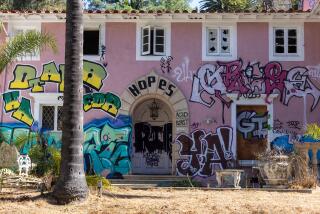Bunker Hill’s first mansions--the elegant, gingerbread homes...
- Share via
Bunker Hill’s first mansions--the elegant, gingerbread homes that made the hill famous--were from the days when women carried parasols, men wore derbies and loud traffic meant whinnying horses.
The architectural style was borrowed from New England, New York City, New Orleans--wherever the owner happened to be from.
Yet, in a way, the houses were unique to Los Angeles. Some had mansard roofs with the distinctive double slopes. Others had dormer windows, elaborate latticework, stout balconies and porticoes, and separate carriage houses. Their stylishness was gauged by their frills.
In its heyday, Bunker Hill was noted for its lawns and gardens and the stately trees along its quiet streets. It was home for the city’s leading families and the place where Presidents stayed.
In 1901, Angel’s Flight, a quaint cable railway, was built up the side of Bunker Hill from Hill Street to Olive Street. Its two orange-and-black funicular cars, named Sinai and Olivet, carried an estimated 100 million commuters and tourists for a nickel on the 45-second, 325-foot ride. The “world’s shortest railway” was torn down in 1969 so 30 feet of the hill could be sliced off.
The once-fashionable neighborhood of lavish 19th-Century mansions began going to seed in the late 1920s as the city expanded westward. By the 1940s, many of the mansions had become rooming houses. What had been a gilded enclave became a place where immigrants could find cheap housing. The influx of newcomers after World World II led to more rooms for transients and hastened the decline of the hill’s stature.
Newspaper accounts called it a “topographical bulge” and a “festering sore--a cancer that had to be wiped out.”
Bunker Hill’s dimly lit streets and dark alleys became a common location for filming motion pictures featuring crime and high-speed chases.
Vagrants gravitated to the growing number of vacant buildings. Fires were commonplace, and policing the crime-ridden neighborhood became difficult. The number of thefts and the number of assaults by juveniles were among the highest in the city.
In March, 1959, the city finally designated Bunker Hill, with its population of 9,000, a blighted area.
On a misty May morning two years later, the Community Redevelopment Agency bought the first of more than 30 parcels it would acquire on the hill. It paid $68,500 for three pieces of property with rotting structures built between 1890 and 1896.
The demolition of these structures made urban renewal seem unsavory to many people. Critics demanded an end to the harsh treatment of property and especially the disregard for people displaced by the bulldozers.
Long after Bunker Hill’s last skyscraper is built, some people will still dispute the wisdom of uprooting thousands of people and bulldozing their homes, no matter how dilapidated. Redevelopment, they say, need not mean destroying part of a city’s architectural history.
Last week, the redevelopment continued with the opening of the 17-story, 439-room Inter-Continental Hotel, where rooms start at $119 a night.


